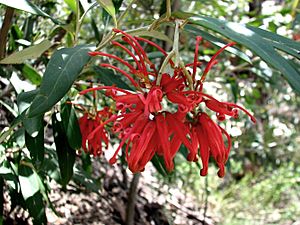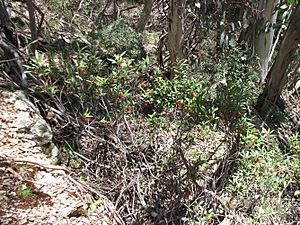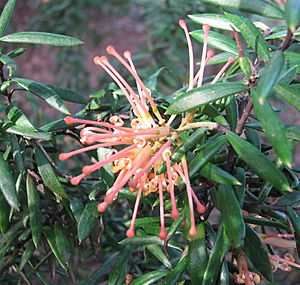Royal grevillea facts for kids
Quick facts for kids Royal grevillea |
|
|---|---|
 |
|
| Above: Grevillea victoriae subsp. victoriae in Mount Buffalo National Park, Victoria | |
| Scientific classification | |
| Genus: |
Grevillea
|
| Species: |
victoriae
|
| Subspecies | |
|
|
The Grevillea victoriae, also known as royal grevillea or mountain grevillea, is a beautiful shrub that grows naturally in south-eastern New South Wales and the mountains of Victoria in Australia. It's a special plant that adds color to the Australian landscape.
Contents
What Does the Royal Grevillea Look Like?
The royal grevillea is a shrub that can grow from a small bush, about 0.2 meters (8 inches) tall, up to a large plant of 4 meters (13 feet) high. Its leaves are shaped like an oval or egg, and they can be quite long, from 1.5 to 14 centimeters (0.6 to 5.5 inches). They are also between 0.5 and 4.5 centimeters (0.2 to 1.8 inches) wide.
In spring and summer, this plant shows off its amazing flowers. They hang down in clusters and can be bright red or orange. These colorful flowers make the royal grevillea easy to spot!
How Was the Royal Grevillea Named?
The royal grevillea was first officially described in 1855 by a botanist named Ferdinand von Mueller. He was a government botanist for Victoria. Mueller found this plant in 1853 when he climbed to the top of Mount Buffalo. He was very impressed by it, saying it was a "truly majestic plant." The name victoriae was given to the plant in honor of Queen Victoria.
Where Does the Royal Grevillea Grow?
You can find the royal grevillea in rocky, mountainous areas of south-eastern Australia. It grows in forests, woodlands, and heathlands. It often grows near other trees like the snow gum and alpine ash.
There are different types, or subspecies, of the royal grevillea, and they grow in specific places:
- The G. victoriae subsp. victoriae is found on some of Victoria's tallest mountains. These include Mount Bogong, Mount Buffalo, Mount Buller, Mount Hotham, Mount Howitt, Mount St Bernard, and Mount Torbreck.
- The G. victoriae subsp. nivalis grows in the high mountain areas around Mount Kosciuszko in New South Wales. It can also be found in nearby ranges, sometimes even above the treeline where most trees stop growing.
- The G. victoriae subsp. brindabella lives in the Brindabella Range, which is on the border between New South Wales and the Australian Capital Territory.
Who Visits the Royal Grevillea?
The bright flowers of the royal grevillea are a favorite food source for many birds. Eastern spinebills and yellow-faced honeyeaters love to drink the sweet nectar from its flowers. In Kosciuszko National Park, many birds leave the area once the royal grevillea stops flowering in January, showing how important this plant is to them.
Scientists believe that these plants do not grow back from their roots after a fire. Instead, they rely on their seeds to start new plants.
Is the Royal Grevillea Protected?
Yes, some types of royal grevillea are protected. On the list of rare or threatened plants in Victoria, the victoriae subspecies is listed as "rare." The nivalis subspecies is considered endangered, meaning it is at high risk of disappearing.
Can You Grow Royal Grevillea in Your Garden?
The royal grevillea is known for being a tough and reliable plant to grow in gardens. It has been successfully grown in all parts of Australia, and even in other countries like New Zealand, the United States, and Great Britain.
If you want to grow one, it needs a spot where the water drains well. It also likes full sun or a little bit of shade. Trimming the plant can help it stay in a nice, compact shape. Since it comes from mountains, it can handle cold weather, frost, and even snow very well.
This plant is great for creating a screen in your garden or for attracting birds. In some parts of North America, hummingbirds even feed on its flowers during winter!
It's easy to grow new plants from seeds or by taking cuttings. Sometimes, gardeners will graft them onto other Grevillea robusta plants to help them grow stronger.
Popular Types of Royal Grevillea
Many different types of grevillea have been created by mixing the royal grevillea with other grevillea plants. These are called hybrid cultivars. Here are a few examples:
- 'Audrey'
- 'Bairnsdale'
- 'Canterbury Gold'
- 'Glen Pearl'
- 'Lady O'
- 'Orange Box'
- 'Poorinda Constance'
- 'Poorinda Golden Lyre'
- 'Poorinda Leane'
- 'Poorinda Pink Coral'
- 'Poorinda Queen'
Images for kids








